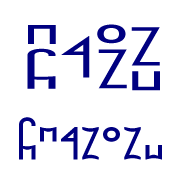 Gaits
Gaits
On the Principles page, I mentioned that Musa can be written in several different Gaits. The underlying word - the 1D form - is the same, but the visible 2D form is different. In particular, the gaits differ on how vowels are written, in relation to consonants. All gaits are written from left to right in a row, with rows following each other down the page, and subsequent pages to the right or behind the current page.
Gaits are implemented by the font, as ligatures and contextual alternates. So, for example, you could change the font on your Chinese document to change between Alphabet and Fangzi gaits - the underlying data is the same. But each language is normally written in a single gait; for example, English is always written in Alphabetic gait, and Chinese in Fangzi gait, even when an English name is embedded in a Chinese text.
Here is an example: the word for twenty in eight different languages, each representing a different gait.
Why does Musa offer multiple gaits?
Before talking about the individual gaits, let's discuss why gaits are useful. All languages are a sequence of sounds, but those sounds are grouped together into larger units in different ways: words, mora (consonant + vowel), syllables, akshara (consonant clusters + vowel), or sequences of consonants. That's one of the reasons why the scripts of the world are of different types: alphabets, abjads, abugidas, syllabaries, and characters. The various Musa gaits focus readers on those units, highlighting what's important in each language.
For example, there are many languages in East Asia whose syllables fit a fixed pattern : each syllable has its own meaning, even when combined into a longer word, and has at most five elements (initial, semivowel, tone, vowel and final) drawn from limited sets. In this system, it's important to delimit each syllable so that they can be recognized as a unit. The Fangzi gait also makes similar syllables more different, helping us recognize them more easily.
In contrast, English words have complicated syllables, with varying lengths, consonant clusters, and many choices at each position. The division into words is very important, while the division into syllables isn't that important. For English, an alphabet enables us to build up words sound by sound. And the Alphabet gait even allows us to indicate word stress - very important in English - without using accent marks. Most of these traits are shared by the other European languages, and they use Alphabet gait, too.
In English, we have words like queen or cube that have a semivowel onglide before the vowel, but even though we have special spellings for them - they're not kween or kyoob - they're not part of a regular pattern. But Slavic languages like Russian have fairly complete parallel series of hard and soft consonants, called broad and slender in Celtic languages, and in cases like that we use those same semivowel letters as suffixes, and we write them attached to the consonant they modify. That's called Ligature gait.
But there are many languages, from all over the world, whose syllables are restricted to consonant+vowel, and they often don't have many of either. In this category fit almost all the Austronesian languages, in addition to many of the world's less-studied languages and even Japanese. For these languages, Kana gait is the best choice, since an alphabet would be too short - there are too few symbols to make words as different as they should be. For example, Hawai'ian has only 8 consonants and 5 vowels, and an alphabet makes many words look alike. I'm srue yuo've seen thsoe snetneces yuo can raed eevn wehn teh leterts aer jmbeuld. But the Hawai'ian syllabary has 40 kana, three times as many distinct symbols.
There are also many languages with mostly consonant + vowel syllables, but a few syllables have either final consonants or initial consonant clusters. In some of these languages, vowels are important, and we write them in Akshara gait. In others, vowels are somewhat less important: related words share consonants, but not necessarily vowels (like English goose and geese); for them, we use Abugida gait. In yet others, vowels play an even lesser role, and we use Abjad gait. In these last two categories fall the Afro-Asiatic languages.
The Niger-Congo languages are the opposite: vowels are very important. There are many initial vowels, one-vowel words, and more variety of vowel. Vowels are also modified for tone, tenseness, nasality and length. These languages are written in the Syllabary gait, in which vowels stand out.
The Arabic script is an abjad whose short vowels are normally not written. That makes sense in Arabic and some other Semitic languages, where the vowels are grammatical and can be inferred (just as stress can be inferred in many languages) if you know the language. It makes less sense in Farsi and Urdu, also now written in the Arabic script. Musa writes Farsi in Alphabet gait and Urdu in Akshara gait, but writes Arabic in the Abjad gait.
Musa is featural, and so all Musa gaits can be analyzed down to the letter and below. We also don't consider that it's important whether the parts of a single grapheme are connected like in Kana gait or simply adjacent as in Fangzi gait. Finally, Musa always writes all vowels, so the only inherent vowel is the virama.
So we're not using the gait names in their scholarly senses. We've just chosen names for the gaits that describe what level they focus on, not the details of how they work. Gait names are Capitalized, while I'll keep the scholarly terms in lowercase. In all cases, using the appropriate Musa gait focuses the reader on the salient scale of the text, whether that be words, syllables, mora, vowels, or consonants.
The Alphabet Gait
Most of the Musa you've seen so far has been in the Alphabet gait. It works like the Roman alphabet we use to write English and most European languages : each letter is written separately, in its own space, and words are separated from each other by a space (filled with a dot). Consonants are composed of two shapes: one on top and the other on the bottom. Vowels are just as wide as consonants, but they're only half the height, so they can be written either high or low.
The Alphabet gait is used for most languages that currently use a real alphabet. However, many languages that were first given written forms in the last century or so, usually by scholars, missionaries or colonists from alphabet-using languages, should choose whichever gait is most appropriate. In those cases, which gait to use depends on the phonology of the language. In general, Alphabet gait is used for languages with consonant clusters, diphthongs, and a wide variety of syllable lengths and formulas. We offer both monospace and kerned fonts for Alphabet gait, as well as decorative and technical fonts.
The Ligature Gait
Alphabet gait with ligatures is another gait - it's a different way to rearrange the letters so that phonological units are easier to see. A ligature consists of two consonants that share some feature and function as a unit. Two consonants normally need four shapes, but a ligature only displays three of them: the fourth is implied or shared.
For example, Musa has ligatures of consonants plus a suffix, where the slender top of the suffix is omitted. We also have ligatures for homorganic affricates, where the bottom spells the shared place of articulation.
Ligatures are used in many other gaits, too, so we should really call this Alphabet gait with Ligatures. But that's too long!
The Alphabet and Ligature gaits cover many of the world's languages, but not all of them. The next four gaits cover Africa and south and southwest Asia. In all four, the consonants are familiar from Alphabet gait, but the vowels differ, both in placement and in form, reflecting their behavior in the various languages. Here's a preview, showing the name Musa in all four:
The Abjad Gait
The Abjad gait is a gait for Semitic languages like Arabic and Hebrew, in which a word is built around a trio of consonants. This root is the skeleton on which words are built by adding vowels to show inflection and derivation. In the traditional Arabic script, short vowels are usually not written, since readers can infer them (jst as yu cn infr thm in Englsh). A special letter (hamza in Arabic) is used to write a lone vowel. But in the Musa Abjad gait, vowels are always written out, above or below the preceding consonant.
As you can see looking at the sample above, Abjad gait is very similar to Alphabet gait - the only difference is that the vowels are smaller, and written above (for high vowels) or below (for low vowels) the preceding consonant.
One important difference between Musa Abjad gait and the Arabic alphabet is that in Musa, long vowels and diphthongs are also written above or below the consonants - they don't interrupt the root as they do in the Arabic alphabet. Long vowels can use the long mark or the corresponding semivowel, whichever makes more sense for the language. These semivowel offglides are written with the short versions of the semivowel:
| جواد | تجويد | جوود | |
|---|---|---|---|
| jawaad | tajwiid | juud | |
| with semivowel | | | → |
| with long mark | | | |
There's one trick. In the last entry in the semivowel line above, the first version moves the w semivowel up next to the vowel, as in the other entries. But in the second version, I've added a Zero-Width Non-Joiner before the w to keep it as an independent consonant, because it forms part of the root in this case. That trick enables Musa to keep the triconsonantal root looking familiar as the vowels change around it. The ZWNJ is available on a Musa keyboard as Muna. (This trick doesn't work in Chrome because of a known bug. For those of you using Chrome, the second version should look like this: )
Cursive Abjad Gait
Because Sunni Islam prohibits figurative art, the Muslim world has a long tradition of ornamental script. Here are some examples in the traditional script, both old and new:
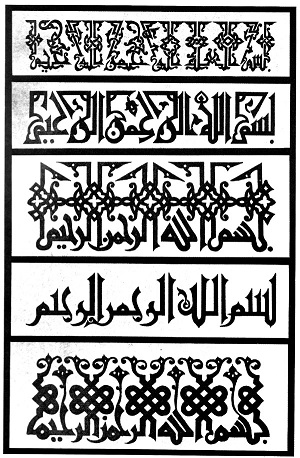
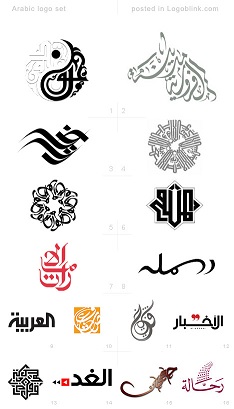
Musa can also be written in a cursive Abjad gait. Please bear in mind, as you compare the traditional and Musa versions, that traditional calligraphy has had fifteen centuries to develop their beautiful ornamental forms, while Musa is just beginning. If you are a calligrapher, perhaps you'd like to show us how beautiful Musa script can be.
The basis idea is to write each word as a zigzag of consonants. Each Musa consonant is slanted to the left, so that the bottom is offset half a letter from under the top. Then a connecting line runs from the bottom to the next top. High vowels are written above the preceding bottom, and low vowels below the preceding top.

Here's the name of the famous Caliph of Baghdad, Hārūn 'ar-Rashīd bin Muḥammad bin 'al-Manṣūr, the hero of the Arabian Nights, written first in normal Abjad gait and then in cursive Abjad:

It's also possible to write Musa in a cursive Alphabet gait. The only difference is that the vowels are part of the cursive zigzag, instead of being diacritics. The empty half of a vowel is written as a gentle curve with no kinks at all.
The Syllabary Gait
The Syllabary gait is used for Niger-Congo languages, including Yoruba, Igbo, Fula, and the Bantu languages, including Swahili, Zulu, Shona, Sesotho, and many more.
Like the Kana gait described below, the Syllabary gait focuses readers on mora of consonant + vowel. But unlike the Kana gait, the Syllabary gait makes vowels stand out much more: they enclose the consonants. It's a good choice when vowels are varied: by tone, by length, by nasality, or even by tenseness - many Syllabary languages have vowel harmony.
Many of the Syllabary gait languages now write long vowels as doubled, even though (unlike consecutive different vowels) they form part of the same syllable. The Musa notation is an improvement: we use a second column of diacritics with the Long mark and a second tone accent, if needed. The graphical form underscores that it's longer than a single mora, but not two distinct syllables.
Again asking you to refer to the sample above, you can see that vowels in Syllabary gait are much bigger than in Alphabet gait. High vowels completely enclose the top of the preceding consonant, while low vowels enclose the bottom. The shapes of the consonants have also been adjusted to fit into the centers of the vowels, but otherwise, consonants and vowels both have familiar shapes.
The Abugida Gait
Abugida gait is used for most of the Afro-Asiatic and Nilo-Saharan languages, but not the Semitic languages, which use Abjad gait. In the Abugida gait, vowels are written as decorations on the preceding consonant. Each vowel is always in the same position, high or low, but the positions are different. This helps readers identify the vowel quickly.
The Akshara Gait
The Akshara gait may also seem unfamiliar at first. Vowels are written as "flourishes" above, below, and to the right of the preceding consonant. The vowel shapes themselves are truncated: usually, the left half is missing. But they're still recognizable with a little practice. Here's a chart showing all the Akshara vowels in the Ramanujan Musa Akshara font, with the corresponding Alphabet vowels in red:

You can see that close vowels have the vowel shape at the beginning of the flourish, either towards the midline for tense vowels or away from it for lax vowels. The mid and open vowels don't have that little "head"; they're just missing the left halves.
Lone vowels are written with a Break as a carrier, even initially. Lone consonants are simply written without a vowel, but if they form a cluster with the following consonant, they may connect to form a conjunct. Vowel suffixes (the long and nasal marks) are written opposite the vowel, in the same column. In tonal languages like Punjabi, accents are written above (for low accents) or below (for high accents) the vowel.
Here's an example: a quote (from Kālidāsa) showing Akshara gait compared to the same phrase in numerous Brahmi-derived scripts :
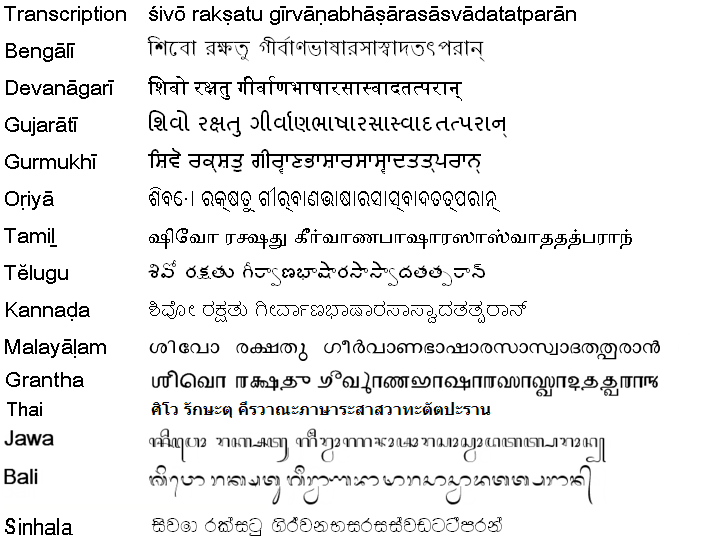
(Unfortunately, I don't have the chandas for the original, so I've put the stress on the last heavy matra, just to show how stress is marked.)
The Fangzi Gait
How can people read Chinese? Those characters are so complicated! It's common knowledge that we don't read by sounding out each letter, but by comprehending the entire "word picture" in a glance. That's why typography is so important, and why weird fonts are so hard to read.
The Fangzi Gait is the Musa version of Chinese characters - it's a way to compress all the letters of a word into a small space, to show the boundaries of each word more clearly, and still to make words look as different as possible from each other within the constraints of a phonetic script (which Chinese writing is not). In other words, we're trying to keep all the advantages of Chinese writing with none of the disadvantages.
The Fangzi gait is used for languages which share most of the following criteria :
-
The language is analytic and/or isolating : each syllable has its own meaning (even if they combine to form longer words) and doesn't change its form.
The language is tonal (it has lexical tones) or uses vowel registers based on phonation. (However, Khmer is not tonal.)
Syllables conform to the pattern initial consonant + medial + vowel + tone + final (offglide or consonant), although one or more of these five elements may be missing in an individual word or in the entire language.
These five elements are drawn from relatively limited stocks; in other words, there are only a few of each, but they're used in many combinations, so there are only a few nonsense words but many homonyms. For example, many of these languages use only finals drawn from m n ng p t k l r.
The language is currently or was once written using Chinese characters.
The list of languages that fit these criteria is dominated by east Asia :
-
The Sinitic languages, like Chinese (Putonghua), Cantonese (Yue), Fukienese (Min), and Shanghaiese (Wu)
The Tibeto-Burman languages, like Tibetan and Myanmar (Burmese)
The Austro-Asiatic languages, like Vietnamese and Khmer
The Tai-Kadai languages, like Thai, Lao and Zhuang
The Hmong-Mien languages, like Hmong (Miao)
I used the words word and syllable above without clarifying, and there's some confusion about what a word is. In most of these languages, every syllable is a morpheme - it carries a meaning on its own - but syllables still combine to form longer words. For example, the Chinese word for tomorrow is 明天 míngtiān, whose two components mean bright and day. The English also breaks down into to (meaning at, on) and morrow (meaning morning). But tomorrow and 明天 are both still one word, not two.
In the current scripts for these languages, there is no separation between words, further muddying the distinction between a word and a syllable (or morpheme). (With the pinyin romanization, Chinese has now introduced rules for when to use a space between words.) But in Musa, we do separate words.
The goal of Fangzi gait is to make each syllable look as distinctive as possible, despite being composed of the same shapes in the same square. Here's how it works: each block is written in a large square that measures 3x3 square "cells" the size of a Musa vowel. In this large square are arranged the following elements :
-
The Initial consonant (marked as yellow "I" below), combined with any following Medial ("M") to form a ligature
The Tone (marked as red "T" below), stretched to double width or height
The Vowel (marked as green "V" below), stretched to double width or height
The Final offglide or consonant (marked as blue "F" below)
The Initial consonant or ligature always fills the entire lefthand column. This helps to establish the rhythm of characters. If there's no initial, a null initial is used; which one depends on the language. For example, Chinese and Korean use the yh letter, while Thai and Vietnamese use a Catch. If there is no final, a Break is used in its place, so that there is always a visible final.
The position of the tone, vowel and final depend on the tone:
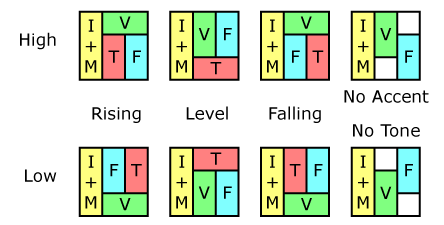
But these elements are always written in the same order, no matter what their position within the character: initial+medial, then high vowel+tone or tone+low vowel, then the final. In other words, the stroke order is the same as the encoding order.
In some languages, there is a tone with no accent mark, for example mid tone in Thai, level tone in Vietnamese or 3rd tone in Cantonese. In these cases, the vowel is high in the second column, and the final is low in the third. But there are also syllables with no tone at all - "weak" syllables in Chinese, for example - and in those cases, the vowel is low in the second column, and the final (or a Break, if there is no final) is high in the third column.
Korean is written in Alphabet gait, even though Hangeul looks like a character gait. Many Korean words are polysyllabic, and the internal consonants assimilate to each other and the surrounding vowels. This assimilation is not written in Hangeul, but it is in Musa, so it makes sense to regroup the contexts into an alphabetic word instead of syllabic characters. Nor is Korean tonal.
The patterns above are enough to handle most of the cases. Here are some examples from Chinese :

There are a few other patterns. If there are two finals, for example an offglide and a final consonant, as in Chinese (below), Myanmar, or Vietnamese, then the second final is written full-height in its own column:
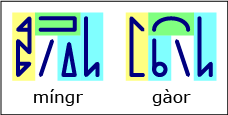
If the initial is a consonant cluster, as in Thai or Khmer, then the two initials are both written in their own full-height columns. Here's the Thai word เปลี่ยน plìːa̯n, which means change. It has an initial cluster, a vowel, a centering offglide and a final consonant!
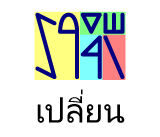
Myanmar and Khmer also feature sesquisyllabic words with a minor first syllable. These can be written in Musa as one character:
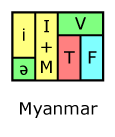
In Khmer, which is not tonal, these minor syllables might even include a medial r (marked as a yellow 'r' below) or end in a nasal (marked as a blue 'N' below).
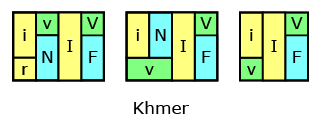
In many of these languages, there are also a few words that merit special attention, for instance er in Chinese (Beijing dialect) and mh in Cantonese. But they're written in the same style.

And here is the Cantonese particle a, used to soften questions. It has "no" initial (a glottal stop), no semivowel (there are no semivowels in Cantonese), no accent (mid tone) and no final!

As you can see, Musa Fangzi gait doesn't have as much variety of design as Chinese characters do, but Musa compensates with more variety of stroke - curves, triangles - and with more use of empty space.
The Block Gait
Block gait is used for languages with independent syllables that combine, but unlike the Fangzi languages, are not tonal. The pronunciation of the syllables may also change more than in the Fangzi languages, so that it's not as important to preserve a constant visual picture of a syllable. A good example is Korean: it's not tonal, and the widespread assimilation and revoicing means that the sounds change ... and so does their Musa spelling.
Like Fangzi gait, Block gait is written in columns that are three cells tall. But Block gait doesn't stretch consonants to that height. A consonant and its following vowel are written in a single column. If the vowel is high, as are most vowels in Korean, it's written above the preceding consonant. But if it's low, like depressed vowels in Korean, then it's written below the preceding consonant. If there's a medial, it's combined with the consonant as a ligature. If there's a final consonant, it's written alone in the next column. There are spaces between words. Here are all the possible patterns for syllables:
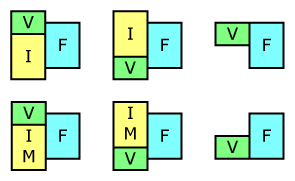
Here's an example: the phrase 한글어 hangeul-eo "for Korean":
The Kana Gait
The Kana gait is used for Japanese and the other languages of Japan. Each syllable consists of one consonant and one vowel (called a mora), combined into a square symbol called a kana. The consonant is written normally, but it has the vowel sticking out from one side of the bottom, sideways or maybe even upside down.

Low vowels are written low, and high vowels are written high, but not as high as the top of the consonant.

To illustrate how the vowels connect, here's an example of each bottom:

The vowels of the first group attach to the "waist" of the consonant: low vowels hang down from the waist, and high vowels float up from the waist. Note that if the bottom is pointy (the first two columns), the vowel goes on the same side as the stem, and you have to retrace some of the stem to get back to the waist. The low vowels of the second group sit on the "foot" of the consonant, and high vowels - written upside down! - are connected by a quarter circle.
Vowels without a preceding consonant are written with a Break, always at the lefthand side of the kana. However, Breaks aren't needed after spaces. A Break may also be used to indicate a missing vowel, if needed, for example between a final consonant and an initial semivowel that might otherwise be interpreted as a suffix.

Consonants without a following vowel, for instance the first consonant of a cluster, an offglide or a final consonant, are also written alone. The moraic nasal and moraic obstruent of Japanese are written this way, for instance the p and n in the word teppanyaki :

Usually, languages written in Kana gait have only simple CV or CVC syllables, but initial digraphs using suffixes are common, too. The sequence consonant + suffix + vowel is written as one kana, using the ligature as consonant, and so is prenasal + consonant + vowel. For example, here is the Japanese word 病気 byōki :
Element Gait
There's one more gait, which isn't used for any language - it doesn't have letters! It's used to write words that are being spelled out, shape by shape. It's called Element Gait:

In Element gait, the shapes that rotate when they're on the bottom - - are written rotated, and the shapes that change when connected are written changed, but the shapes aren't connected: there are no stems.
Choosing Between Gaits
The choice of which gait to use for a language depends partly on phonology and partly on culture. Here's a guide:
-
We use Alphabet gait for the European languages that now use the Roman alphabet, like English or Spanish. We also use Alphabet gait for Turkic languages like Kazak, and Austronesian languages like Malay. Indigenous languages with complicated syllables, like Inuit, also use Alphabet gait.
Languages like Russian or Irish that need a suffix for many sounds use Ligature gait.
Semitic languages like Arabic and Hebrew use Abjad gait, which maintains the visual image of the triconsonantal root by exiling the vowels above and below the line of text.
Afro-Asiatic languages like Hausa and the Ethiopic languages use Abugida gait, which is kind of halfway between Alphabet and Abjad: the vowels are in the line of text, but as decorations on the consonants.
Niger-Congo languages use Syllabary gait.
Indian languages use Akshara gait.
We mentioned above the criteria for Fangzi gait: usually isolating and tonal with syllables that conform to a pattern. That includes Chinese, Vietnamese, and Thai, for example.
Korean uses Block gait
Japanese uses Kana gait
Having said that, the first guess should probably be the gait that most resembles the current orthography. Here's a map that shows the current situation:

And here's a small tool that tells you which gait we recommend for a language. Enter the ISO 639 2-letter code for the language.
Recap of Gaits
Here is a list of Musa gaits showing the name of each gait, written in that gait, along with a font or two in that gait, a description of the languages that use it, and some examples:
| Alphabet | | Dushan, Kraljevo | Roman (Latin) | English, Spanish, Malay, Turkic |
|---|---|---|---|---|
| Ligature | | Taunus, Yousuf | Cyrillic | Russian |
| Abjad | | Averroes | Semitic | Arabic, Hebrew |
| Syllabary | | Njoya | Niger-Congo | Yoruba, Igbo, Swahili, Zulu |
| Abugida | | Kaleb | Afro-Asiatic | Hausa, Ethiopic |
| Akshara | | Ramanujan | Indo-Aryan, Dravidian | Hindi, Bengali, Urdu, Tamil |
| Fangzi | | Zhouhei, Kunming, Wangkai | East Asian | Chinese, Vietnamese, Thai |
| Block | | Sejong | Koreanic | Korean |
| Kana | | Yasuhiro | Japonic | Japanese |
| Element | | Hentrax | blind, OCR | |
| < Punctuation | Letter Names > |
| © 2002-2025 The Musa Academy | musa@musa.bet | 19feb25 |


